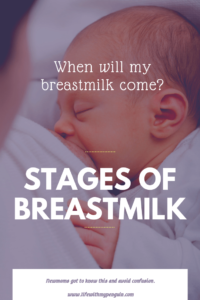A mother is born with a newborn. Is a new mother well informed about breastfeeding and details about breastmilk?
If you think breastfeeding is natural, yes, you got it right. But this natural process is a learning curve. Parents, yes parents, often find it tough to decode the mystery of breastfeeding. There is colostrum, transition milk, breastmilk, nursing positions and many more. Let’s start with “The stages of breastmilk”.
Starting with, the word of the world breastfeeding week “Breastfeeding”
The process of nourishing infants or older children by the mother’s breast is breastfeeding.
Sadly, fathers cannot do it. But they can do every other thing for their kids except breastfeeding. Let say, breastfeeding is the superpower of a mother.
Stages of breastmilk

Colostrum
The first stage of breastmilk is Colostrum. A newborn feeds on Colostrum if breastfeed. It is liquid gold. One can say it as the newborn superfood. Colostrum is the forerunner to breastmilk. It is light yellow, or golden or clear in color, and thick, creamy liquid.
What is colostrum?
Medically, Colostrum is ‘the first milk secreted at the time of parturition, differing from the milk secreted later, by containing more lactalbumin and lactoprotein, and also being rich in antibodies that confer passive immunity to the newborn, also called “foremilk”. It lasts for 2- 4 days after the lactation is started. Colostrum is a very important component of breast milk and it has a role to play in the immune system of every mammal.’
Colostrum is high in carbohydrates, protein, antibodies, and low in fat. As newborns may find fat difficult to digest. It has a mild laxative effect, encouraging the passing of the baby’s first stool, which is called meconium. This clears excess bilirubin, a waste product of dead red blood cells which is produced in large quantities at birth due to blood volume reduction, from the infant’s body, and helps prevent jaundice.
Colostrum contains large numbers of antibodies called “secretory immunoglobulin” (IgA) that help protect the mucous membranes in the throat, lungs, and intestines of the infant. Leukocytes are also present in large numbers; these begin protecting the infant from harmful viruses and bacteria. Ingesting colostrum establishes beneficial bacteria in the gut tract.
While feeding colostrum, a new mother might not feel heavy and full around her breasts. In some cases, this might lead to confusion for the mother if the baby is well-fed or not. It might seem that the newborn is not getting enough.
How much colostrum does a newborn need?
Precisely, newborns have very small digestive systems about 1 – 2 teaspoons and do not need much to fill up. Also, the colostrum delivers its nutrients in a very concentrated low-volume form.
Does a newborn need formula supplement?
A newborn does not need to have supplements by formula unless one absolutely has to.
Premature babies tend to fare better on human colostrum than commercial infant formulas. Human milk contains special components, called growth modulators, that help the premature baby’s digestive system adjust to oral feedings. Research indicates that premature babies fed formula tend to vomit more and continue tube feeding longer than that fed human colostrum and breast milk.
Transitional milk
Colostrum was the starter and before going to mature breastmilk, there exists transitional milk, the next stage of breastmilk. When the mature breast milk begins to produce and mixes with colostrum, it is called transitional milk.
When does transitional milk come in?
Transitional milk usually appears in 1-2 weeks depending on the milk-making cells. A mother’s milk changes the composition and is loaded with bioactive components with hormones, gut-friendly bacteria, and cells. This transition milk takes over the colostrum before passing on to mature breastmilk. The changes meet the growing demands of the baby’s development.
When would a mother feel milk coming in?
This is usually the time when the milk comes in. The mother might feel changes in the breast. They grow heavy, fuller and swollen. As the days pass by, the texture and color of transitional milk will change from creamy yellow to thinner white almost-mature milk.
Transitional milk vs colostrum
Along with the changing texture and color, the nutritional profile of the milk also changes. With the change from colostrum to mature milk, the amount of protein and antibodies in transitional breast milk begins to go down a little bit. But, the amount of fat, sugar, and calories increase. These higher levels of fat, sugar, and calories help the baby to gain back some of the weight that was lost in the first few days after birth.
Mature breastmilk
The final stage of mother’s milk. About a month later after birth, the breastmilk changes completely to mature milk. The composition of the milk won’t go dramatic change much further unless the baby needs extra defense. Yet few slight changes if not drastic do happen.
Foremilk and Hindmilk
When the breastfeeding session starts the foremilk, thin watery low-fat milk comes out. Then the hindmilk comes out that is creamier and higher fat. The baby should get a healthy mix of both to avoid any physical health trouble. An imbalance might cause gassy baby or greenish, watery, or frothy poop.
Further the concentration of breastmilk changes throughout the day and night. Many nursing women notice greater volume and faster flow in their breastmilk in the early hours of the day, the evening milk contains elements to help baby sleep.
Moreover, the breastmilk changes in amount and nutrients as the baby grows.
During growth spurts or wonder weeks and illness the baby needs of mature milk changes. Through growth spurts or wonder weeks, the fat content of milk rises. Studies have shown that breastmilk can also change when a baby is sick or the mother is exposed to illness. When a baby is sick, she passes on a cue through her saliva that sends a signal to her mother’s body to produce more milk with illness-specific antibodies. Similarly, if the breastfeeding mother is exposed to a virus, she will produce antibodies that get passed on to the baby for protection.
The mature milk is usually white, light-yellow or blue-tinged. Occasionally, the color of mature milk depends on the mother’s diet and the color of food eaten. At times, the milk might have blood from sore, cracked nipples or blood from milk ducts. The mature milk looks similar to skim milk, thinner and watery.
Now the breastfeeding mother’s breasts may appear somewhat softer and smaller than they did during the transitional-milk stage, though they will still be larger than before pregnancy. These changes in breasts and in milk are normal and are designed to provide baby needs for nutrition, growth, and development.
The production of mature milk is usually set by time. It is produced depending on the breastfeeding and/or pumping habits and baby’s needs. The more a mother breastfeed and/or pump, more milk is formed. A pure demand-supply model of economics.
WHO recommends exclusive breastfeeding infants till the age of 6 months, thereafter they should be given nutritious complementary foods and continue breastfeeding up to the age of two years or beyond. Mother and child often choose the period of lactation, few mothers nurse till toddlerhood. That’s extended breastfeeding.

In case, if a mother is unsure about milk production it is advisable to take medical care or consult with lactation consultants.
Breastfeeding is nature’s gift. But if a mother chooses to formula feed due to a medical condition, lack of support system or choice, it doesn’t make her a lesser mother. Let her enjoy the Motherhood, support her.
As a new mother or a mother of multiples did you face any trouble while breastfeeding?
Head over to my next post as I share the “Breastfeeding challenges”.
References:
- http://www.foodandnutritionjournal.org/pdf/vol1no1/1_1_4_p37_47_Colostrum_MEENA.pdf
- https://en.wikipedia.org/wiki/Colostrum
- https://www.verywellfamily.com/immunoglobulins-antibodies-in-breast-milk-431993
- https://www.parentingscience.com/breast-pumps-and-baby-formula.html
- https://www.nhs.uk/news/2009/10October/Pages/Breast-milk-ingredients-and-sleep.aspx


Pingback: Hyperlactation - The story of too much breastmilk - Life with my Penguin
Pingback: Evolution of parenting - Life with my Penguin
Pingback: The mommy thumb - Life with my Penguin
Pingback: Breastfeeding struggles: Real Stories - Life with my Penguin
Pingback: Understanding Hyperlactation - symptoms and management - Life with my Penguin
This is good info. Thanks for writing.
Thanks for reading!
Pingback: Breastfeeding struggles: Real Stories – Life With My Penguin